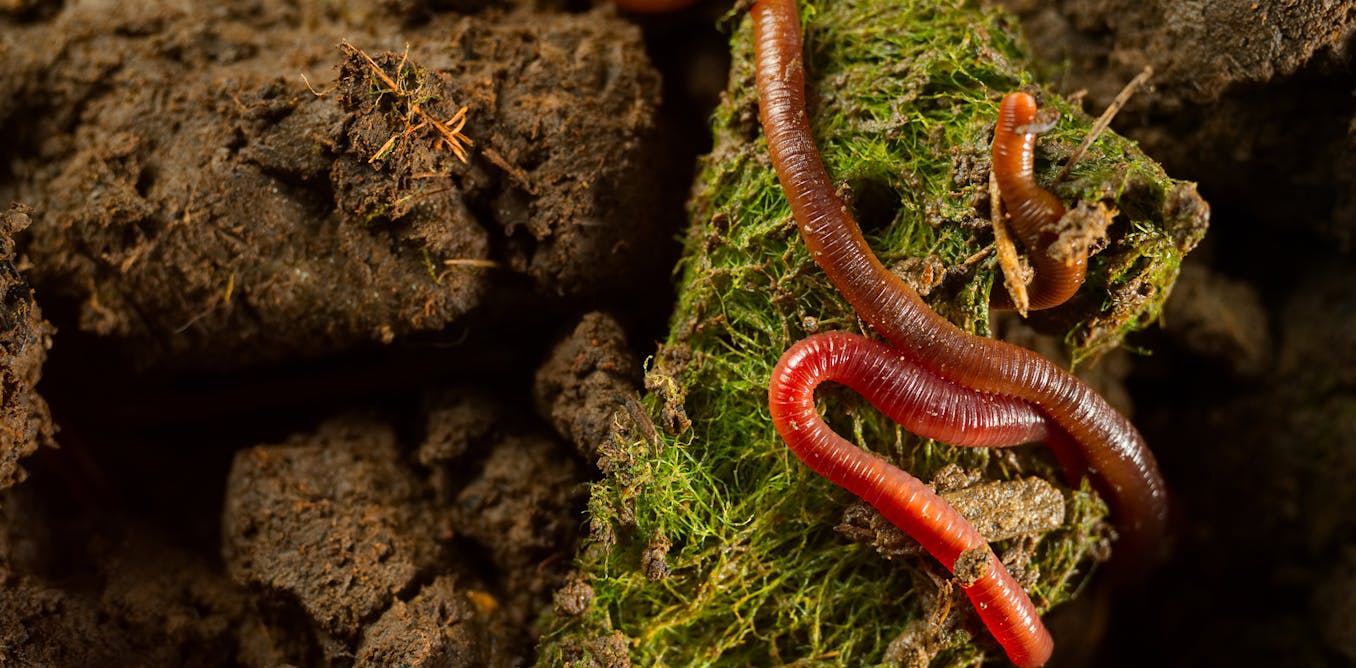Most people are aware of earthworms, but probably give them little thought. Some have a notion they are “good for the soil”. Others regard them with distaste and think of slimy animals associated with decay. But these alien-looking animals are remarkable and control the foundations of life from their subterranean world.
Earthworms engineer the soil that grows the food we eat and the flowers we love to look at. Indeed, they are the primary drivers in soil formation.
The earthworm gut is a bit like a biological reactor where numerous processes take place. The combining and processing of organic matter and mineral soil produces earthworm casts (faeces), both below and above ground which increases soil fertility. Burrows in the soil also allow water and air to circulate freely.
Rain worms
Earthworms are not only vital to the ecosystem, they are also fascinating animals.
Anyone venturing out in spring or autumn after overnight rain may find dying earthworms on hardstanding. People sometimes think these animals have left their burrows to avoid drowning, but that’s not even close to the truth. Having no lungs or gills, earthworms breathe through their skins. Our lungs diffuse oxygen from the air we breathe in, but oxygen can diffuse just as easily through earthworm skin from water. Earthworms can live underwater for days.
So why do they come to the soil surface during rain? Well, it’s most likely to disperse and find new places to live away from close relatives to avoid inbreeding. The vibrations of raindrops encourage them to come to the surface – a wet ground is easier to cross than a dry one.
Nighttime offers some protection from predators. The worms seen by us on the pavement the following day are those that failed to find a new place to burrow down. Some earthworm predators exploit this behaviour through “foot trembling”. Gulls are prime examples and stomp their webbed feet on wet areas of grassland to fool worms into surfacing in a belief that it is raining. This technique works very well.
Scientists have identified 6,000 species of earthworm, around 30 of which live in Britain. All of them can be divided into three groups. The first live in organic-rich material, like a compost bin. These include the tiger worm or brandling (Eisenia fetida) and are great at breaking down material such as household vegetable peelings.
Other, unpigmented earthworms eat soil and make horizontal burrows close to the soil surface. These include the grey worm (Aporrectodea caliginosa).
The third group are larger, deep burrowers (around one metre below the surface) such as the dew worm or nightcrawler (Lumbricus terrestris). They use their mouth to pull leaves into their permanent, vertical burrows.
The actions of these groups of worms benefit each other. For example, the feeding and burrowing of the nightcrawler enriches the soil that the grey worm eats. Additionally, all earthworms have complex interactions with soil microorganisms like bacteria and fungi, which are found in large numbers in their casts.
Finding a mate
All earthworms are hermaphrodite (have both male and female reproductive organs) but some produce young from unfertilised eggs. The majority copulate underground, but a few, including the nightcrawler, mate on the soil surface, which is because their vertical burrows stop them meeting below the soil.
Scientists have observed an interesting behaviour above the soil that happens before copulation, when reciprocal sperm exchange happens (each fertilises the other). In worms like the night crawler, the two worms “visit” the burrow of their prospective partner with their head end, while keeping their tails in their home burrows. Each can stretch a long way (about 30 cm).
Kevin Butt
These burrow visits may last from 30 seconds to several minutes. Visits take place in both directions before copulation, which happens facing in opposite directions and may last three hours. Further research has demonstrated that only worms of a similar size tend to mate. They deduce the size of a potential mate by feeling its burrow entrance.
As hermaphrodites, it is in the interest of each worm to be both a successful “mother” and “father”. This increases the number of young produced and therefore the survival rate. All worms produce cocoons from their “saddle” (the raised area on their bodies). They make a tube of protein which slips off their front end after filling it with their own eggs and stored sperm from a partner. They then deposit it underground as a lemon-shaped cocoon.
This hatches after some weeks, depending on the species. Some species of worm surround the cocoon with leaf fragments as a first meal for their young.
During mating, the earthworms lock together by piercing each other’s skin with setae (hair-like projections from the skin) to create a close fit for sperm to flow between them along a groove.
After mating the two worms separate by withdrawing into their burrow with a “tug-of-war”, ripping out these setae from the skin of the partner. If unequal in size, one would completely pull the other from its burrow and leave it unable to return and therefore be eaten by a predator.
Strategies in drying soils
Earthworms evolved mucus-covered skin which retains moisture and makes movement through the soil smoother. But, as soft-bodied and water-rich organisms, they are at the mercy of soil conditions. Under adverse soil conditions, such as when soils become too dry (in summer) or too cold (in winter), earthworms resort to survival strategies, evolved over millennia.
These include waiting at the bottom of a deep burrow where the soil is damper and entering a resting state curled in a knotted ball in a mucus-lined chamber in the soil (a form of hibernation).
Earthworms have evolved to produce cocoons that can stay dormant until conditions improve. The cocoons hatch when the soil is moist and warm and the small emerging worms grow to maturity, which can take up to a year in some species. With changes in climate happening and predicted to worsen, earthworms face an uncertain future.
This should concern everyone – our future is interlocked with earthworms’.



